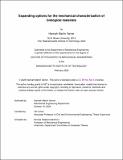Expanding options for the mechanical characterization of biological materials
Author(s)
Varner, Hannah Martin
DownloadThesis PDF (16.04Mb)
Advisor
Cohen, Tal
Terms of use
Metadata
Show full item recordAbstract
The mechanical properties of biological tissues change over time and with disease progression, and they provide important information regarding the limits a tissue can sustain before injury. Therefore, quantifying these properties in biological materials and their synthetic simulants could be instrumental for accurate medical diagnoses, treatment of disease, and prediction of traumatic injury survivability. Conventional methods of mechanical testing, such as uniaxial tension, compression, and nanoindentation, provide highly repeatable and reliable results for the stiff materials for which they were originally developed. However, the same cannot be said when these methods are applied to the characterization of soft and biological materials due to limitations of specimen size, fixturing capabilities, and sample preparation. Volume Controlled Cavity Expansion (VCCE) is a recently developed technique to measure local mechanical properties of soft materials in their natural environment. Through the highly controlled expansion of a fluid bubble at the tip of an injection needle, paired with simultaneous measurement of the resisting pressure, a local signature of a material's mechanical response can be obtained.
This thesis presents the first systematic application of VCCE to biological materials. It begins by presenting a cautionary example of the limitations of soft material testing, focusing on the synthetic silicone and tissue simulant polydimethylsiloxane (PDMS). We find that the wide range of mechanical properties reported in literature are due to biases imparted by different testing methods. We then use VCCE to examine the elastic response of gelatin, whole blood clot and liver tissue, demonstrating with high repeatability that subtle mechanical changes occur within a matter of days as these tissues age. Finally, this work applies VCCE to investigate what happens to these materials after elastic expansion, and throughout a process of controlled damage. Biological materials are found to demonstrate toughening that does not appear in gelatin and PDMS. Because of these observed differences, we caution against using gelatin and PDMS for simulating the behavior of biological materials in extreme loading cases. Combining these findings, this thesis provides evidence that more widespread adoption of VCCE in mechanical testing would provide a path to better understanding of the mechanics of soft and biological materials, with implications in fundamental mechanics research as well has in biological and healthcare applications.
Date issued
2025-02Department
Massachusetts Institute of Technology. Department of Mechanical EngineeringPublisher
Massachusetts Institute of Technology